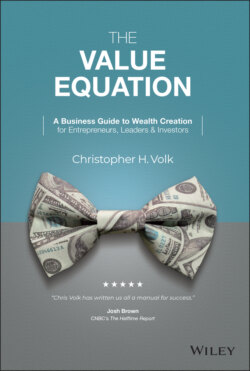The Value Equation

Реклама. ООО «ЛитРес», ИНН: 7719571260.
Оглавление
Christopher H. Volk. The Value Equation
Table of Contents
Guide
Pages
The Value Equation. The Value Equation A Business Guide to Wealth Creation for Entrepreneurs, Leaders & Investors
Preface
Introduction
Chapter 1 Free Enterprise and Wealth Creation
In the Beginning Is the Idea
Unicorn Likelihood
Odds of Success
The Six Variables
Notes
Chapter 2 Daymond John and the First Variable
Accountants vs. Entrepreneurs
Variable #1: Business Investment
Note
Chapter 3 The Capital Stack and Two More Variables
The Right Side
Other People's Money (OPM)
Variables #2 and #3: Amount and Cost of OPM
Cost of Capital vs. Cost of Equity
Capital Stack Assembly
Equity Sourcing
Notes
Chapter 4 Three More Variables and Voilà!
Variable #4: Sales
Variable #5: Operating Profit Margin
Variable #6: Annual Maintenance Capital Expense
Putting the Six Variables Together
Gordon Growth Model
Equity Valuation
The Miracle of Compounding
Dissecting Investment Returns
Chapter 5 The Value Equation
The V-Formula
The Case Study V-Formula
EVA and EMVA
Making the V-Formula Even Simpler
The Case Study V-Formula (2:1 Sales to Business Investment Ratio)
The Case Study V-Formula (4% Maintenance CapEx Ratio)
The Case Study V-Formula. EMVA Creation
Solving for Other V-Formula Variables
V-Formula in Reverse. Determining the Desired Amount of OPM
V Formula Variation. Determining OPM Interest Coverage
V-Formula Data Tables
Note
Chapter 6 Business Model Evaluation
STORE Capital
STORE Capital's 2019 V-Formula
The FAANGs
Notes
Chapter 7 Pulling the Corporate Efficiency Levers
Operating Efficiency (O) Sales
Sales
Operating Profit Margin
Operating Profit Margin
Asset Efficiency (A) Business Investment
Business Investment
Maintenance CapEx
Maintenance CapEx
Capital Efficiency (C) OPM Variables
OPM Variables
Six-Shot Economics
Note
Chapter 8 Choosing from Your OPM Options
Designing Your Own OPM
Leasing
Creating a Model to Evaluate OPM Options
Real Estate as an Investment
Note
Chapter 9 Opportunity Cost
Some Opportunity Cost Illustrations
Creating a Model to Evaluate Real Estate Lease Opportunity Costs
Case Study V-Formula. 20% Location Expansion Case
Chapter 10 The Final Form of OPM
OPM Equity
Sustainable Growth Rate
Taking on OPM Equity
Current Equity Rate of Return When You Don't Own the Entire Company
Deciding How Much OPM Equity to Use
Creating a Five-Year Model
Sweetening the Deal
OPM Equity Flavors
OPM Equity Considerations
Note
Chapter 11 A Look at Public Companies
Determining Public Stock Equity Returns
Public Shareholder Business Investment
Adjusting Reported OPM for Assets Leased Rather Than Owned
Walmart
Note
Chapter 12 Animal Spirits
Elon Musk and Tesla
Stock Exchange Differences
Restaurant Case Studies
Lone Star Steakhouse & Saloon
Boston Chicken
Value Investing
Notes
Chapter 13 Mergers and Acquisitions
OPM Capital Options
Solving for Equity and Company Valuation
Valuing a Business in Three Steps
EBITDA Valuation Multiples
M&A Risks and Rewards
M&A Nightmares
GE and M&A-Driven Growth
Focusing on What Matters
Notes
Chapter 14 The Essential Ingredient
The Growing Restaurant Illustration
Designed Structural Change
Technology-Enabled Changes
Core Competency Refinement
Keeping It Simple
Planned vs. Imposed Structural Change
Blockbuster Video
Designed Revolutionary Change
Reengineering the Corporation
Notes
Chapter 15 The Art of the Possible
The Circles of Business Life
Evolving Capital Choices
Value vs. Momentum Investing
Defining a Financial Win
Some Final Thoughts
Notes
Glossary of Terms
The Value Equation Framework. Current Pre-Tax Return on Equity. The V-Formula
The V-Formula Deconstructed
Relative V-Formula for Current Pre-Tax Return on Equity
Equity Valuation Multiple
Equity Value
Equity Market Value Added (EMVA)
Sustainable Growth Rate
Current Equity Rate of Return With Partial Ownership
Market Return on Equity. The Market V-Formula
Company Valuation
Compound EMVA Growth Formula
Acknowledgments
About the Author
Index
WILEY END USER LICENSE AGREEMENT
Отрывок из книги
Additional Praise forThe Value Equation: A Business Guide to Wealth Creation for Entrepreneurs, Leaders & Investors
“We're living through a historic boom in entrepreneurship. People are starting businesses at record rates. Fortunately, Chris Volk has written us all a manual for success.”
.....
After I started to work at the bank, I became interested in business models. From my earliest days in banking, I began to model out businesses and create projections, which helped me to develop an expertise in business model evaluation. I cut my teeth on Visicalc (the first spreadsheet software for personal computers), graduated to Lotus 123, and later moved on to Excel, which is the prevalent spreadsheet software in use today. My earliest financial models can be described as long and weighty.
The thing about most business models and projections is that they are bound to be wrong. In fact, I commonly saw companies put together “base case,” “best case,” and “worst case” financial model scenarios, which simply gave the model authors the opportunity to be wrong three times. In truth, with just one or two variable changes, business model outcomes can vary by great degrees. Given this high level of variability, I became wedded to sensitivity tables (or “data tables” in Excel), which allowed me to see potential outcomes given a range of values for any two key model inputs. If you created many sensitivity tables, you could incorporate numerous variables, which provided better insight into key model variables and margins for error. The best business models tend to have ample room to make mistakes and yet still create wealth through outsized investor returns.
.....